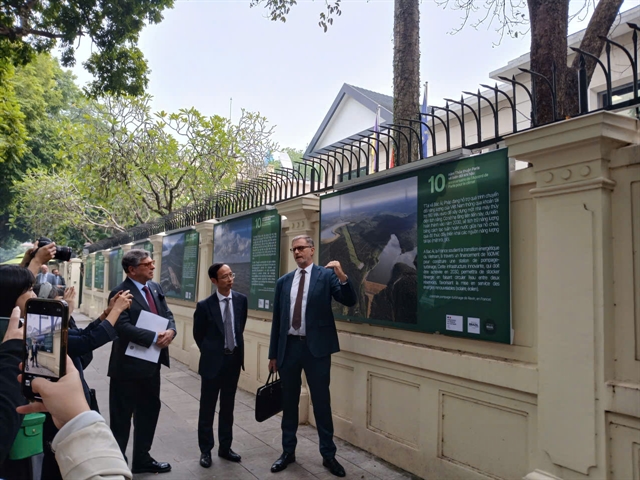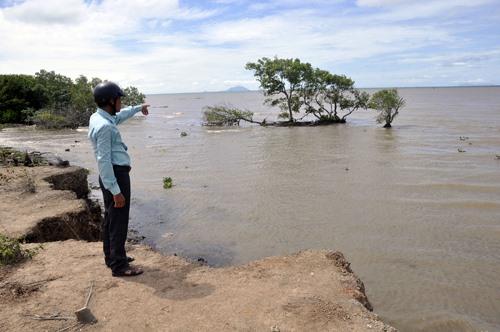 Environment
Environment

Increasing land erosion as a result of disappearing mangrove forests threaten the livelihoods of farmers living in coastal areas
 |
| Mangrove forest in Hà Tiên Province. Without the protection of mangroves, waves and tides are hitting the sea dyke harder, hastening erosion and increasing the risk of breaches.—Photo www.panoramio.com |
KIÊN GIANG – Coastal communities in the south are in danger of losing their livelihoods to increasing land erosion resulting from the loss of a natural buffer - mangrove forests.
For many years now, landslides have become a common phenomenon in Kiên Giang Province’s Hòn Đất District, with Thổ Sơn, Lình Huỳnh, and Bình Giang communes among the worst hit.
The most gravely affected area is the strip of coastal land stretching from Hòn Quéo Hamlet in Thổ Sơn Commune to Bình Hoà Hamlet, Bình Giang Commune. Mangrove forests have completely disappeared in some sections here.
Without the protection of mangroves, waves and tides are hitting the sea dyke harder, hastening erosion and increasing the risk of breaches.
Trần Trọng Thân, a resident of Hòn Me hamlet, said he’d been allotted a coastal mangrove forest area of six hectares 13 years ago. Erosion has reduced this to a little over 1.5 hectares at the moment.
Similarly, Nguyễn Văn Thụ of Bình Hoà Hamlet said that in the past two years alone, the coastal protection forest assigned to his family has lost some 30 metres to the sea.
Two layers
The mangrove forests of An Biên and An Minh Districts stretch through 10 communes with total length of 60 kilometres, covering an area of 4,000 hectares, and are divided into primary and secondary protection layers.
The primary protection layer is a 1.120 ha area of white mangroves (avicennia marina), and the secondary layer is a 3,000ha area of red mangroves (rhizophoraceae).
This protective area has been weakened in many sections where the sea has penetrated several kilometres inland and broken down the landmass along 25 kilometres of the coastline.
Most of the secondary layer forests have been allotted to households for protection, management, as well as economic exploitation within prescribed limits.
Residents say that in the last two years, coastal erosion, exacerbated by climate change, has swept hundreds of hectares of aquaculture farms and nearly 60 per cent of the original mangrove area into the sea.
Previously, the main source of income for the households was aquaculture under the forests’ canopy, but worsening erosion and diminishing incomes have forced many to relocate.
Solutions
Given the threat of climate change and harmful human actions, radical are needed to ensure the safety of sea dykes, officials say.
“Only when the dykes are secure can we hope to maintain the forests and guarantee people’s livelihoods,” said Nguyễn Thanh Linh, Deputy Director of the An Biên – An Minh Forest Management Department.
While most residents living in the proximity of the mangroves are aware of the importance of the buffer zone, there are many who have destroyed the mangrove forests, weakening the protection layer, he said.
The actions of such people have affected the community’s aquaculture farms as a whole, he added.
Regeneration efforts
In addressing the issue of erosion in coastal areas of Kiên Giang Province, officials are seeking solutions to regenerate lost mangrove forests.
Trương Văn Thước, Chief of the Vàm Rầy Forest Management Station under the Hòn Đất – Kiên Hoà Forest Management Board, said that apart from measures currently in place to protect and expand existing mangrove forests, the board has selected plants suitable to each area’s soil conditions so as to improve survival rates.
They hope this will help create sustainable, good quality forests, especially in areas currently at risk of serious erosion, he said.
Phạm Văn Hùng, Director of the Hòn Đất – Kiên Hà Forest Management Board, said they have set up a five-hectare nursery to prepare trees for a six-year (2015-2020) project to restore and develop coastal mangrove forests in Giồng Kè Hamlet.
The board will continue its efforts to safeguard the forests with the engagement of coastal communities, he added.
In doing so, they are following directions from authorities higher up to promote new, climate-smart models of farming, including the selection of resilient plants and livestock breeds, such as melaleuca cajuputy and Snakeskin gourami.
The board is also trying to demarcate coastal protection forests and speed up reforestation and afforestation of mangroves.
Local authorities also said that they are working to clarify the rights and duties of those allocated forest areas to encourage the growth of mangroves in coastal areas. – VNS
 |
| Coastal erosion, exacerbated by climate change, has swept hundreds of hectares of aquaculture farms and nearly 60 per cent of the original mangrove area into the sea.—Photo baotintuc.vn |




